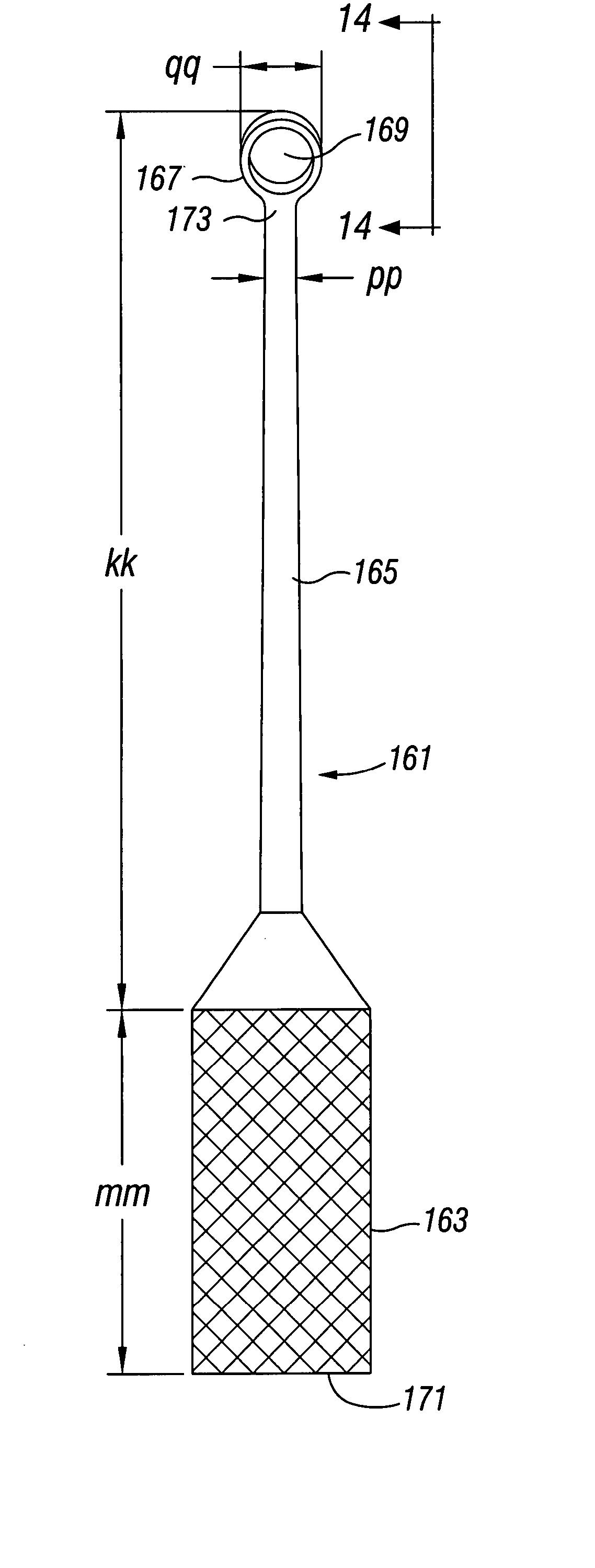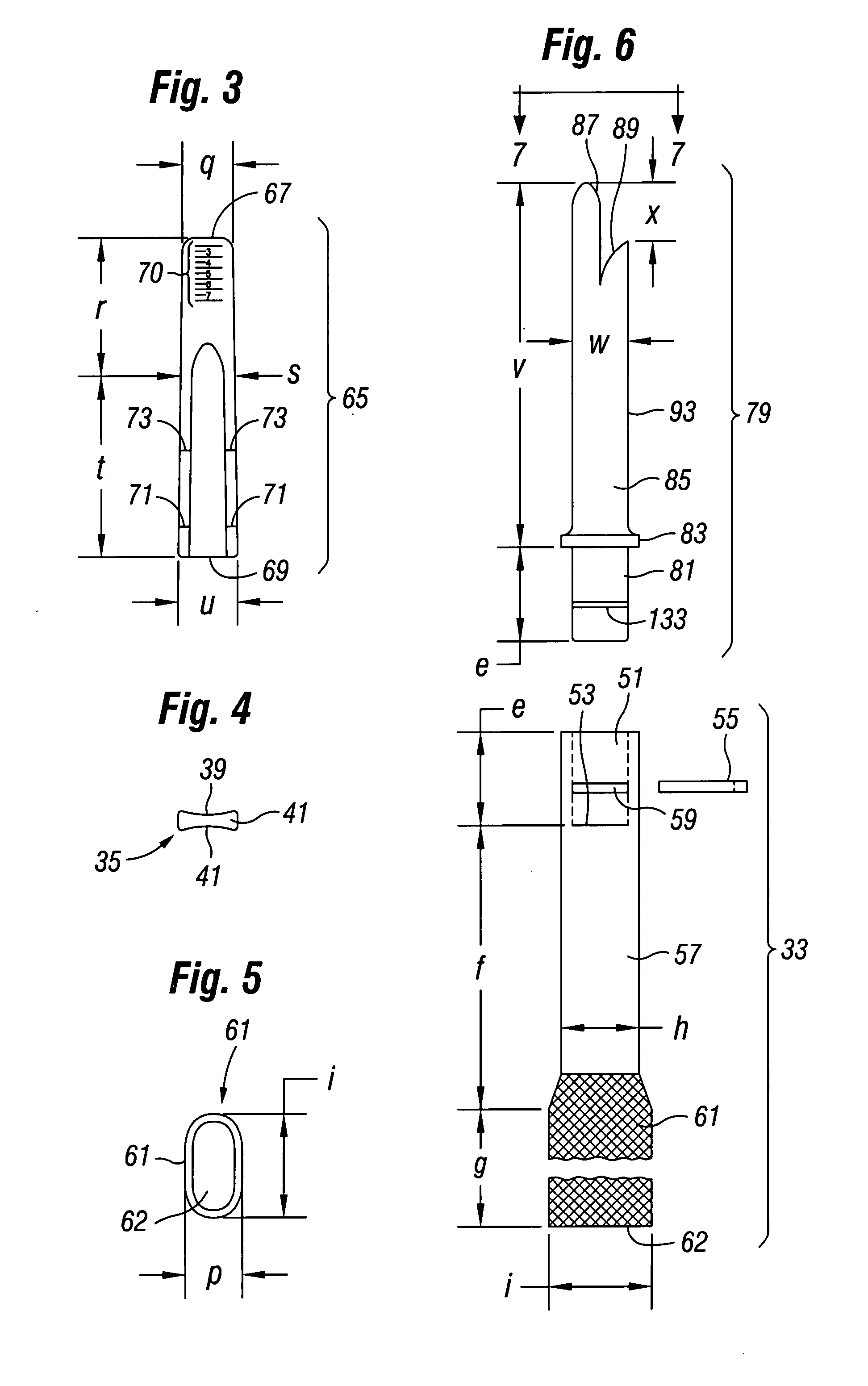However, there have been increasing reports of non-union when initially fusion was thought to have occurred and
subsidence with sinking of the implants into the
vertebral body.
This causes a loss of height of the
spinal column with narrowing of the foramina and potentially compression of the exiting
nerve root.
Furthermore the long term effects on the body from the entrapped
metal implant and its local effects on the spine are unknown.
If removal becomes necessary due to pain or infection the metallic cages are virtually impossible to remove without endangering the greater vessels overlying the anterior spine and necessitating massive destruction of the involved vertebrae.
This creates an almost impossible situation to re-stabilize the spine.
A serious problem exists with respect to the surgical procedure of accessing, preparing the space between adjacent vertebrae, and in inserting and positioning the femoral ring allograft.
The spreading levers are thin, and relatively narrow and thus potentially and actually unstable increasing the danger of inadvertent injury of surrounding tissues.
The spreading device is bulky, long and since it extends straight into the space between the two
vertebra, it blocks the approach and takes up valuable space and blocks needed vision into the critical operative area.
Unfortunately, the pliers-action implant holder must push the implant into a space which has a height taken up by the thickness of the distractor blades.
This poses the danger again of dislodging the spreader device potentially causing tissue and vascular injury.
Aside from the inherent
instability of having spreaders, the use of the triple jointed spreading device requires excessive spreading in order to achieve its goal of providing working room to shape the interspace.
Overspreading of the interspace can damage, even fracture, the vertebra.
It also potentially damages the discs above and below the working level and can cause
neurological injury with foraminal compression.
The spacing tool is cumbersome because the
handle which extends straight from the operational area further gets in the way of the surgeon.
Insertion of the spacing tool is also cumbersome as it can be inserted only if the size of the inter vertebral opening exceeds the clearance size of the width of the rectangular
paddle.
Because the natural
disc space is biconcave, the surgeon is faced with the problem of fitting a rectangular profile object into an elliptical space.
This results in poor contact between the end plates of the adjacent vertebra and the surface of the bone graft which militates against successful fusion.
If the surgeon chooses to carve a rectangular space to accommodate the spacer or the graft, he must necessarily remove a great deal of the all important end plate thereby weakening the most structurally supportive part of the vertebra.
This then subject the fusion site to subside and thereby resulting in unwelcome
deformity with loss of normal
spinal curvature and foraminal narrowing.
The
insertion using a poor grasping tool typically allows rotation or
lateral displacement of the graft before the surgeon has a chance to make final placement and secure it.
Current surgical instruments available for this purpose do not enable both access, full disc removability and interspace shaping without obstructing the surgical field or unduly lengthening the time required for the procedure.
The use of any combination of these instruments still does not achieve the goal of a safe, quick and anatomically shaped interspace to match a like contoured implant.
Extensive use of curettes is
time consuming and leaves an uneven end plate surface.
Osteotomes and chisels are often too short for safe application and will not result in the ability to perform precision work.
High speed drills can be quick, but can easily wrap up adjacent
soft tissue resulting in catastrophic vascular injury.
It is also difficult to control in the more posterior recesses of the interspace and can transgress the posterior rim and inadvertently enter the
spinal canal and cause permanent
neurological injury.
Another feature lacking in surgical instruments is the ability to remove instruments in a way which will not encourage side to side loosening.
When an inserted instrument becomes jammed,
lateral movement or force will tend to damage the surrounding areas.
The surgeon's lack of control over
exit angle as well as
entry angle is a problem in performing this type of procedure.
This is especially complicated by the fact that major blood vessels lie to either side of the operative area.
The obstruction of the surgical field is another problem.
Extremely long, complicated instruments, especially those instruments which have hand engagement members located far from the surgical field, cause a significant obstruction problem.
The resulting obstruction is both significant and hazardous.
Implants, such as femoral diaphyseal rings currently used give the surgeon problems of (1) rotating in the interspace during
insertion, (2) not remaining positioned properly to the
surgical instrument utilized for implantation and fixation, (3) backing out of the interspace, (4) fracturing during insertion and (5) failure to achieve fusion.
No design has yet provided a solution to these problems in the allograft diaphyseal ring implant field.
 Login to View More
Login to View More 


